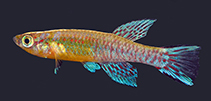| Diagnosis: |
Dorsal spines (total): 0-0; Dorsal soft rays (total): 11-12; Anal spines: 0-0; Anal soft rays: 14-15. Diagnosis: Aphyosemion cyanoflavum is a member of the Aphyosemion ogoense group based on DNA analysis (Ref. 125647). It can be distinguished from all other Aphyosemion species by its cephalic lateral line system, having unique large, dark coloured anterior supra-orbital neuromasts in very wide supra-orbital grooves, 18.3-19.4% of inter-orbital width vs. 7.3-16.9% in other species; very large pre- and postorbital canals with large pores and frontal neuromasts housed in one pit with one anterior lobe; by its wide upper jaw, due to enlarged lacrimal bones, wider than inter-orbital distance versus narrower in all other species, making the dorsal and lateral view of the head much more remniscent of an Epiplatys than an Aphyosemion (Ref. 125647). Males are distinguished from all other Aphyosemion species by their unique lateral colour pattern: anterior part of body on side yellow and posterior side of body purple-grey; the transition between yellow and purple-grey is very sharp and situated just behind the pelvic fin (Ref. 125647). Males are distinguished from all other members of the A. ogoense group, except for A. caudofasciatum, A. pyrophore, and A. thysi, by the presence of narrow dark red bars in the posterior part of the flanks and on the caudal peduncle; males are distinguished from the latter three species by the above mentioned wide supra-orbital grooves and the unique colour pattern of anterior yellow and posterior purple grey on the flanks (Ref. 125647). Description: Dorsal and ventral profile slightly convex, greatest body depth approximately at base of pelvic fin, ventral profile slightly convex, caudal peduncle dorsally and ventrally concave (Ref. 125647). Mouth directed upwards, lower jaw longer than upper jaw, upper jaw wider than inter-orbital distance (Ref. 125647). Frontal neuromasts in one groove with one central anterior lobe, pre-opercular, pre- and postorbital cephalic lateral line system with prominent tubular canals with large pores; two supra-orbital grooves with three neuromasts each; grooves wider and deeper than in other Aphyosemion species; anterior part of supra-orbital groove strongly widened with many melanophores; anteriormost supra-orbital neuromasts large and dark grey to black due to dense concentration of melanophores; dermal lobes bordering the grooves very small, shallow and narrow (Ref. 125647). Teeth on jaws unicuspid, outer row large and inward curved, inner teeth smaller and more irregularly placed (Ref. 125647). Scales cycloid, body completely scaled except ventral head surface; frontal squamation variable, G-type or E-type; G-scale narrow and elonged due to wide supra-orbital grooves; two F-scales present; no scales on dorsal and anal fin base; caudal fin base with two to three scale rows; scales in mid longitudinal series 29-30, transverse series of scales before dorsal fin 9, circumpeduncular scale rows 14 (Ref. 125647). All unpaired fins pointed in males; number of dorsal fin rays 11-12, anal fin rays 14-15; first dorsal fin ray above anal fin ray seven to eight; pectoral fin not reaching pelvic fin, pelvic fin just reaching anal fin (Ref. 125647). Colouration: Live colouration of males: snout dark grey to black; eye iris light with some metallic green areas on outer margin; three red streaks on opercle in approximate 45° angle, top red streak behind eye can be reduced to red spot, lower red streak short or reduced to red spot at the posterior tip of the operculum; anterior part of body yellow with green iridescence, posterior part purple grey, metallic ice blue iridescence, anteriorly in patches, otherwise concentrated at scale border; most scales in upper half of anterior side of body with small red bounded spot forming up to four irregular horizontal lines, lower being very short; lower half of anterior border without or with sparse red spots; majority of scales on posterior part of body with variable larger dark red spots, forming irregular bars; body dorsally brownish, ventrally from chin to halfway between pelvic and anal fin bright yellow; unpaired fins light blue with metallic sheen and dark black or red margin, narrow in anal fin and broad in caudal and dorsal fin, dark red dots and/or short streaks between fin rays; on caudal fin two larger dark red dots at centre of fin base and one large red dot at the ventral caudal fin base; pelvic fin light metallic blue, sometimes with few red spots; pectoral fin hyaline with blue metallic margin (Ref. 125647). Colouration in 70% ethanol: lower lip black to dark grey; operculum and head below eyes light grey, red streaks on operculum as in live specimens; flanks grey with sharp transition to unpigmented whitish ventral side anterior of pelvic fin; large dark grey to black blotch on anterior flank; melanophores of posterior flank scales concentrated on posterior margin of scale; dorsal third of body with irregular lines of red spots; dorsal, anal, and caudal fins light grey, with irregular red dots and streaks between fin rays, and with narrow dark margins as in live specimens; pelvic and pectoral fins light grey at base and dark grey at margin (Ref. 125647). |

